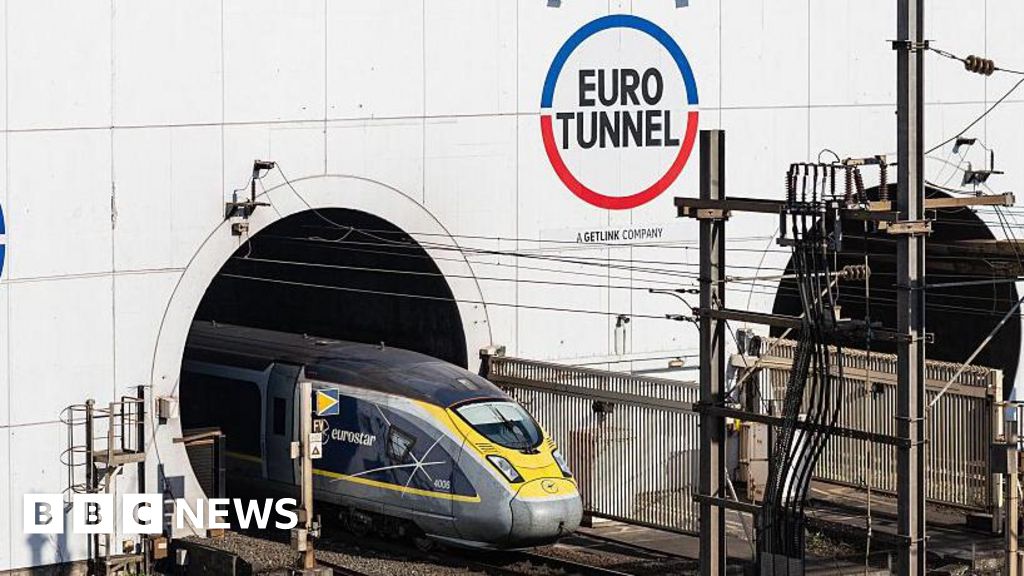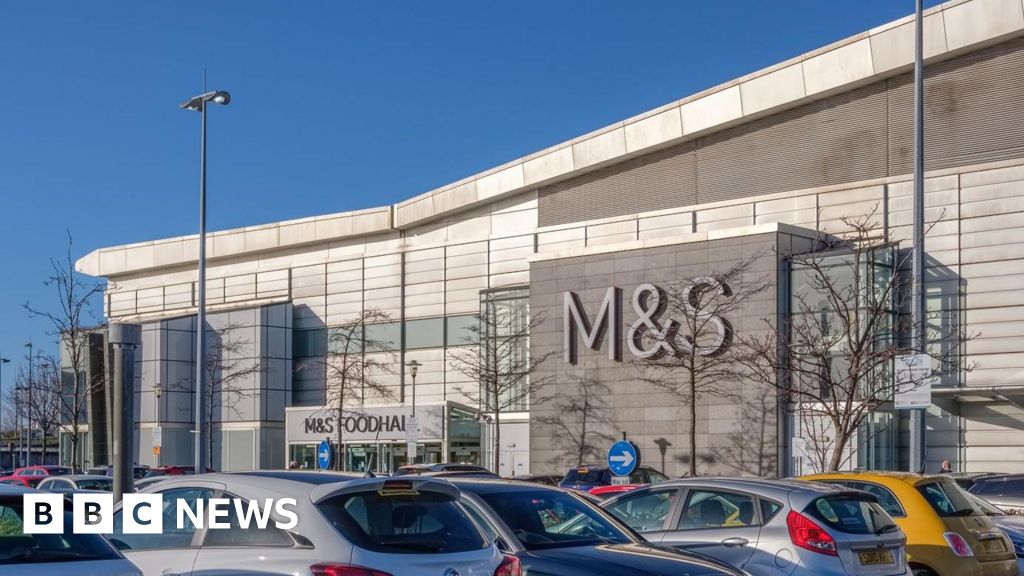- Walmart moves to Nasdaq, marking biggest-ever exchange transfer Reuters
- Walmart to shift listing to Nasdaq as retailer raises sales forecasts Financial Times
- Walmart Is Talking Up Its Tech Focus. A New Stock Exchange Is Its Next Move Investopedia
- Walmart (WMT) Stock Surges on Earnings Beat, Shift to Nasdaq CryptoRank
- Major corporations shift listings to Nasdaq amid growing tech focus TradingView
Category: 3. Business
-
Walmart moves to Nasdaq, marking biggest-ever exchange transfer – Reuters
-

Italian prosecutors investigate luxury group Tod’s for labor abuses, seek ad ban
ROME — ROME (AP) — Italian prosecutors have placed luxury group Tod’s and three of its executives under investigation for suspected labor abuses and exploitation, judicial documents showed on Thursday.
According to the documents, obtained by The Associated Press, Milan prosecutor Paolo Storari has also requested a six-month ban on the company’s advertising, with a hearing on the case set for Dec. 3.
In the documents, prosecutors allege that Tod’s — known for its high-end loafers and bags — was fully aware of and complicit in labor exploitation of Chinese workers at subcontracted workshops in Milan and the Marche region.
In a statement issued on Thursday evening, Tod’s denied any wrongdoing and said it will respond to the allegations in the appropriate courts.
In the documents, Storari noted a sort of “intentional blindness” from Tod’s, which had also carried out third-party audits on the workshops, but failed to address the problems they had revealed.
According to prosecutors, the workers’ exploitative conditions included hours exceeding the legal limit, inadequate wages, violations of various workplace safety regulations and degrading housing.
The probe focusing on Tod’s is the latest in a string of Italian police operations and investigations revealing the abusive treatment of subcontracted workers by high-end brands.
In April, Italian police disclosed that Chinese workers employed by an unauthorized subcontractor, produced handbags and accessories for Giorgio Armani.
Continue Reading
-

Channel Tunnel says UK investment ‘non-viable’ as it halts projects
Eurotunnel, the operator of the Channel Tunnel, has halted its UK projects, claiming “unsustainable” levels of taxation has made any future investments “non-viable”.
The company said it had been informed its business rates would increase by some 200% from next year.
It hit out at the government, arguing that the higher costs were “clearly contrary” to ambitions of growing the economy and increasing investment.
The Treasury said it would support firms “hit hardest” by tax hikes and would continue talks with affected industries over such concerns.
The outburst from Eurotunnel comes days ahead of next week’s Autumn Budget, where Chancellor Rachel Reeves will set out the government’s tax and spending plans.
Speaking to the BBC, Eurotunnel’s chief executive Yann Leriche said: “All our investments, all our plans are becoming unsustainable.
“As you know, business rates, it’s a property tax. And our property – the Channel Tunnel – has not changed. It’s still the same tunnel, the same terminal, the same trains. Everything is equal.
“And so to face such an increase… is a real issue for us. Because we know in rail, we invest for the long term.”
The potential 200% increase in business rates for Eurotunnel is a result of new calculations by the Valuation Office Agency (VOA), which provides the government with valuations and property advice used in setting taxation and benefits.
Mr Leriche said while discussions were ongoing, this could see its business rates rising from £22m to £65m.
A spokesperson for Eurotunnel said such a hike in business rates, along with other taxes, could put its total tax level at about 75% on UK earnings.
The VOA told the BBC the body “does not determine business rates” and that “next year’s liability has not yet been confirmed”.
“This unparalleled and unsustainable level of taxation makes any future investment in the UK non-viable,” the Channel Tunnel said.
“It is therefore impossible to develop new services, create jobs, and pursue what is needed for the long-term development of our activities.”
The company claimed it had “no other choice but to freeze our future investments in railway assets in the UK, starting in 2026”.
The BBC has asked Eurotunnel what investments it has frozen. The Financial Times reported that its chief executive, Yann Leriche, told the newspaper it had scrapped plans to reopen a freight terminal in Barking and to run a new direct freight service from Lille.
The Channel Tunnel is an undersea tunnel linking southern England and northern France. Nicknamed “Chunnel”, it comprises three tunnels, two rail tunnels used for freight and passenger trains, and a service tunnel.
The link between Folkestone and Calais is operated by Eurotunnel.
Separate company Eurostar, Eurotunnel’s biggest customer, operates passenger services through the tunnel between London and a number of other European cities on the continent, including Paris, Brussels and Amsterdam.
A VOA spokesperson told the BBC it had engaged with Eurotunnel and their advisers “on multiple occasions over the past eighteen months to discuss their valuation and fully explain our approach”.
“These discussions remain ongoing, and we are committed to continuing constructive engagement.”
The spokesperson added Eurotunnel could formally challenge the valuation.
Ahead of the Budget, the Eurotunnel called on the government to “provide certainty on business rates”.
The firm has not been alone in issuing warnings to the chancellor, with supermarket bosses claiming part of the government’s business rates reforms posed a problem for its industry.
Business rates are a tax on non-domestic properties such as shops, pubs and offices.
It is expected that Reeves will confirm the rates businesses will have to pay at in the Budget, along with further details, which will come into force in April 2026.
The Treasury said in response to Eurotunnel’s comments that it did not comment on “speculation around future changes to tax policy”.
It said once it understood the “complete” revaluation picture, it would be in a position to “make final decisions” on support.
Continue Reading
-

Top Fed official warns on risk hedge funds pose to $30tn Treasury market
Unlock the Editor’s Digest for free
Roula Khalaf, Editor of the FT, selects her favourite stories in this weekly newsletter.
A top Federal Reserve official has warned that a growing debt-fuelled trade hedge funds are making in Treasury markets could magnify instability in the world’s most important financial market.
Fed board governor Lisa Cook said on Thursday that funds’ so-called basis trades, which take advantage of tiny price discrepancies in Treasuries, risked making the $30tn market “more vulnerable to stress”, and in extreme cases could impact market functioning.
“Outside of episodes of stress, relative value trades substantially improve the efficiency and liquidity of Treasury securities and related markets,” said Cook, who is the governor responsible for financial stability. “Yet, during episodes of stress, the unwinding of crowded positions in such trades could magnify instability in these markets.”
Regulators — including at the Fed — have long cautioned about the outsized role hedge funds have played in Treasury markets.
Funds’ bets on the trade have risen substantially in recent years. The Fed in October published research highlighting what economists described as a “massive increase” in Cayman Islands-based hedge funds’ exposure to US government debt.
It found that the funds had absorbed more US Treasury issuance between January 2022 and December 2024 than all other foreign private holders of US Treasury debt combined.
Cook noted that the proportion of the hedge funds’ holdings of Treasury cash securities had increased to 10.3 per cent in the first quarter of this year — above the pre-pandemic peak of 9.4 per cent.
While the differences in price between Treasuries in the cash market and their equivalents in the futures market are typically tiny, hedge funds borrow huge amounts of money to place these trades, allowing them to multiply their profits.
The trade has been at the centre of multiple financial crises.
The most notable example was in March 2020, when the onset of the Covid-19 pandemic hit markets and forced hedge funds to unwind their basis trades, leading to a rapid shift in Treasury prices that quickly spread panic to other markets and forced the Fed to intervene.
The trade was also at the centre of the 2019 repo crisis when basis traders were forced to rapidly unwind positions after the Fed’s quantitative tightening programme, which removes reserves from the system, created a dearth of liquidity.
The forced selling of both cash Treasuries and futures stressed the short-term funding, or repo market, causing a spike in corresponding interest rates. The Fed forced to step in during this episode too
In 2021, the New York Fed introduced a twice-daily Standing Repo Facility aimed at ensuring short-term borrowing costs remain within central bankers’ target range.
The central bank’s second major quantitative tightening programme, which has run over the past three years, contributed to a rise in repo market rates towards the end of October — on some days above the cost of borrowing from the SRF.
The Fed said last month it would halt the latest QT programme starting December 1, with several officials signalling the US central bank could expand its holdings of Treasuries beginning early next year.
Continue Reading
-

Braehead Shopping Centre sold in possible £220m deal
 Getty Images
Getty ImagesThe owner of Sports Direct has completed a deal to buy the Braehead Shopping Centre.
Frasers Group, which also owns the Frasers department stores, has bought the facility in Renfrew from SGS UK in a deal reported to be worth £220m.
Braehead, which opened in 1999, is home to more than 100 retailers including Ikea, Primark and Marks & Spencer and is among Scotland’s busiest shopping complexes.
In a statement, Frasers Group described the acquisition as a “significant addition” to its “strong and growing portfolio”.
SGS UK bought Braehead in 2020 following the collapse of its previous owner, Intu.
The firm’s CEO, Claire Barbour said it had been able to “stabilise” the centre before its sale.
She added: “The sale of Braehead was always part of our strategic plan and through active management, we have delivered substantial value enhancement, attracting new brands and increasing its relevance and appeal to customers.
“We have created a strong platform from which Frasers Group can continue to drive growth, leveraging its retail expertise to further unlock Braehead’s potential as one of the leading retail destinations in Scotland.”
Frasers Group also owns the Overgate Centre in Dundee and in September, bought the Waterfront Retail Park in Greenock.
Frasers was previously owned by the former Rangers shareholder Mike Ashley.
It has been run by his son-in-law, Michael Murray, for the last three years and now owns high street brands including USC, Game and Evans Cycles.
Mr Murray said: “This acquisition is an important step in delivering our property ambitions and cements the group’s position as a leading operator and champion of physical retail destinations while unlocking greater opportunities to serve communities with the best brands, environments and experiences possible.”
Continue Reading
-

The Luxury Electric SUV Designed Without Compromise, Now Starting at $79,900¹
Debuting at the 2025 Los Angeles International Auto Show, November 21–30
NEWARK, CA. – November 20, 2025 – Lucid Group, Inc. (NASDAǪ: LCID), maker of the world’s most advanced electric vehicles, today announced the launch of the Lucid Gravity Touring, the newest addition to its groundbreaking Lucid Gravity SUV lineup. Starting at $79,900,1 Lucid Gravity Touring now offers Lucid’s signature blend of space, performance, and efficiency to a broader audience.
Customer orders are now open, with select configurations available for immediate delivery at lucidmotors.com/available-vehicles.
“The Lucid Gravity Touring unlocks a new audience for the Lucid brand in the broad and critical SUV segment,” said Marc Winterhoff, Interim CEO at Lucid. “There’s not another SUV in its segment that can deliver the combination of range, interior space, and driving performance found in the Lucid Gravity Touring.”
Expanding the Gravity Model Lineup
Lucid Gravity redefines the SUV category with a clean-sheet design enabled by Lucid’s proprietary EV technology. Lucid Gravity Touring offers the practicality of a full-size SUV within the footprint of a mid-size, seating up to seven adults and delivering game-changing versatility.Built on the same platform as the Lucid Gravity Grand Touring, Lucid Gravity Touring features Lucid’s high-efficiency battery and powertrain architecture, advanced vehicle dynamics, and native NACS compatibility for ultra-fast charging. With an 89kWh battery pack, Lucid Gravity Touring achieves an EPA-estimated range of up to 337 miles.2
Charging is seamless with access to more than 25,000 Tesla Superchargers, thousands of Electrify America DC fast-charging connectors, and a multitude of additional DC fast- charging stations across North America. Lucid Gravity Touring can charge at speeds up to 300 kW at 1000V DC fast chargers to add 200 miles in 15 minutes. When connected to a Tesla Supercharger, Lucid Gravity Touring can charge at up to 220 kW thanks to Lucid’s proprietary rear motor drive unit boost charging capability, which boosts the 500V station voltage to match the high voltage of the Lucid battery pack.
Performance Meets Lifestyle Capability
The dual-motor, all-wheel-drive Lucid Gravity Touring delivers up to 560 horsepower and accelerates from 0 to 60 mph in just 4.0 seconds. Standard air suspension and an optional Dynamic Handling Package delivers refined ride quality and agile handling.Interior configurations include five- and seven-seat layouts with up to 120 cubic feet of adaptable cargo space in the five-seat configuration. Customers can choose from six exterior colors and wheel designs ranging from 20 to 23 inches. The standard Stealth Appearance features dark polished finishes, while the optional Platinum Appearance adds bright silver accents.
The Lucid Experience
The Lucid Gravity Touring inherits the bold design and human-centric technology of the Grand Touring, including:• Clearview Cockpit: A 34-inch curved 6K OLED display, for driver visibility.
• Lucid UX 3.0 + Over-the-Air Updates: A software-defined experience that evolves over time.
• DreamDrive 2 Pro (Optional): Lucid’s most advanced driver-assistance system with 32 onboard sensors.The Lucid Gravity Touring can be configured at lucidmotors.com/configure/gravity.
Los Angeles International Auto Show
Lucid Gravity Touring will make its public debut at the 2025 Los Angeles International Auto Show, November 21–30. Attendees can experience the Lucid Gravity Touring, Lucid Gravity Grand Touring, and Lucid Air Sapphire at Lucid’s South Hall activation. Demo drives will be available on a first-come, first-served basis.Learn more at https://lucidmotors.com/events.
1 For U.S. customers only. Excludes tax, title, license, options, destination and documentation fees.
2 When equipped with 20″F/21″R wheels and configured as a 2-row, 5-seat vehicle. Range and battery power vary with temperature, driving habits, charging and battery condition and actual results will vary.About Lucid Group
Lucid (NASDAǪ: LCID) is a Silicon Valley-based technology company focused on creating the most advanced EVs in the world. The award-winning Lucid Air and Lucid Gravity SUV deliver best-in-class performance, sophisticated design, expansive interior space and unrivaled energy efficiency. Lucid assembles both vehicles in its state-of-the-art, vertically integrated factories in Arizona and Saudi Arabia. Through its industry-leading technology and innovations, Lucid is advancing the state-of-the-art of EV technology for the benefit of all.Investor Relations Contact
investor@lucidmotors.comMedia Contact
media@lucidmotors.comTrademarks
This communication contains trademarks, service marks, trade names and copyrights of Lucid Group, Inc. and its subsidiaries and other companies, which are the property of their respective owners.Forward-Looking Statements
This communication includes “forward-looking statements” within the meaning of the “safe harbor” provisions of the United States Private Securities Litigation Reform Act of 1995. Forward-looking statements may be identified by the use of words such as “estimate,” “plan,” “project,” “forecast,” “intend,” “will,” “shall,” “expect,” “anticipate,” “believe,” “seek,” “target,” “continue,” “could,” “may,” “might,” “possible,” “potential,” “predict” or other similar expressions that predict or indicate future events or trends or that are not statements of historical matters. These forward-looking statements include, but are not limited to, statements regarding plans and expectations with respect to Lucid Gravity Touring, including its order timing and starting price, features, capabilities, equipment, options, configurations, range, charging performance and compatibility, access to the Tesla Supercharger network and Electrify America stations, plans and expectations with respect to the timing of Lucid Gravity Touring’s public debut and experiences at the 2025 Los Angeles International Auto Show, as well as the promise of Lucid’s technology. These statements are based on various assumptions, whether or not identified in this communication, and on the current expectations of Lucid’s management. These forward-looking statements are not intended to serve as, and must not be relied on by any investor as, a guarantee, an assurance, or a definitive statement of fact or probability. Actual events and circumstances are difficult or impossible to predict and may differ from these forward-looking statements. Many actual events and circumstances are beyond the control of Lucid. These forward-looking statements are subject to a number of risks and uncertainties, including those factors discussed under the cautionary language and the Risk Factors in our Annual Report on Form 10-K for the year ended December 31, 2024, subsequent Ǫuarterly Reports on Form 10-Ǫ, Current Reports on Form 8-K, and other documents Lucid has filed or will file with the Securities and Exchange Commission. If any of these risks materialize or Lucid’s assumptions prove incorrect, actual results could differ materially from the results implied by these forward-looking statements. There may be additional risks that Lucid currently does not know or that Lucid currently believes are immaterial that could also cause actual results to differ from those contained in the forward-looking statements. In addition, forward-looking statements reflect Lucid’s expectations, plans or forecasts of future events and views as of the date of this communication. Lucid anticipates that subsequent events and developments will cause Lucid’s assessments to change. However, while Lucid may elect to update these forward- looking statements at some point in the future, Lucid specifically disclaims any obligation to do so. These forward-looking statements should not be relied upon as representing Lucid’s assessments as of any date subsequent to the date of this communication.
Accordingly, undue reliance should not be placed upon the forward-looking statements.Continue Reading
-

‘Robot’ buses could bring more environmental benefits than public transport with drivers
Autonomous self-driving cars and taxis are already on the roads of San Francisco and Beijing. There are also autonomous tram-style services around Oxfordshire and Dubai.
Now researchers in the Italian city of Trento are planning to pilot a scheme of autonomous 17-seater shuttle buses which can divert to the homes of travellers. The first stage of the “robot buses” pilot is expected to cover the historic city centre, where approximately ten vehicles powered by clean hydro-electric energy will operate for up to 18 hours per day.
The pilot is expected to be initially funded by government grants to demonstrate the reliability of this type of vehicle, improving user acceptance so the service could then use private funding to grow to move beyond the city. The starting date is not yet confirmed.
The plan is that members of the public would use an app to call for an autonomous, AI-driven bus to pick them up. A similar transport system already exists using human drivers (for example, there is an app-based Bus on Demand operating in Coventry, UK). Some on-demand bus services, such as Mi-link in Oxfordshire, even use autonomous vehicles, but not to the level of digital integration being explored in Trento.
The Trento pilot plans to use smart roads around the city, part of a national project, where the roads communicate with the autonomous vehicles so that they can have the data it needs to make split-second decisions. This provides driverless vehicles with information about unforeseen events and allows complex coordination and collaborative manoeuvres where driverless vehicles communicate with the roads and with each other.
Read more:
Self-driving buses that go wherever you want? How the UK is trying to revolutionise public transport
The autonomous shuttle expected to be used in Trento is a compact battery-electric vehicle carrying up to 17 passengers manufactured by Toyota.
Toyota
The idea behind the project is that one-to-one replacement of cars or taxis with autonomous vehicles would add a bit of convenience but would not do much for congestion or emissions. It could even be counterproductive if the increased convenience encourages people to travel more.
A more positive scenario is possible when AI enables new transport models such as the driverless shuttle. The Trento team estimate that replacing 100,000 private petrol cars with 5,882 shared electric shuttles could potentially yield around a 92% annual CO2 reduction – an impressive figure, but one that can only be achieved if riding a shuttle becomes more attractive and convenient than driving a car.
Read more:
Driverless cars: what we’ve learned from experiments in San Francisco and Phoenix
Conventional bus services simply are not a sufficiently attractive alternative to car use outside the dense centres of major cities. as they are often infrequent and don’t come close to people’s homes in many cases.
If a new type of public transport could offer a better alternative, then more environmental benefits could emerge. Think of a system where you don’t need to conform to bus timetables and operating times – or even bus routes. The bus comes to you when you call it and takes you where you want to go. Driverless taxis can offer that, but at a higher cost not only financially, but also in terms of congestion and energy consumption.
The planned Trento design is where you have small shared autonomous vehicles offering travel at bus level fares – or lower. The use of driverless vehicles offers potentially radical improvements to the cost and quality of the service that could result in people preferring this type of shuttle to driving their cars.
Small driverless shuttles could operate more frequently and flexibly and even operate a 24/7 service. As the plan is to combine bookings to pool the journeys of passengers going in the same direction, the cost of the ride (which was already low on account of not paying for the driver) becomes even lower for a shared ride.
Read more:
AI can boost economic growth, but it needs to be managed incredibly carefully
Vehicle automation is perceived as having potential risks and benefits. On the one hand, there is a clear risk that jobs in the transport industry will disappear. On the other, autonomous transport will help ensure that people without cars or those unable to drive can maintain access to work.
This kind of public transport system that offers a convenient alternative to personal car use would substantially reduce environmental impact, reduce congestion for all and make for more socially inclusive towns and cities. As the service provides a level of convenience close to that of a taxi, but a cost similar or lower than that of a bus, the possibility of moving society away from car dependence could become more realistic.
Environmentally, it has been estimated that adoption of driverless vehicles in major cities could result in a reduction of up to 34% of the total carbon emissions from transportation by 2050.

In MIlton Keynes, UK, a small driverless pod was introduced in 2014 and a driverless shuttle was trialled in 2023, although these have been limited experiments.
Author provided (no reuse)
What’s happening elsewhere?
Globally other systems are being explored and are likely to emerge in the next few years. Milton Keynes in the UK already operates a small vehicle service booked by app.
The service creates “virtual bus stops” that pick up and drop passengers in locations that are close to their homes and are also convenient to other passengers sharing the same vehicle.
Unlike the Trento service, the service in Milton Keynes is operated by human drivers. Potentially, this limits the flexibility of the service as humans cannot, and should not, operate 18 hours a day without breaks and the number of drivers available limits the size of the fleet.
There are plans to expand this with small autonomous buses on fixed routes, but trials so far have always had a human driver on board for safety purposes.
Projects, such as the one in Trento, plus other emerging autonomous vehicle service systems, start to move cities towards a reinvention of public transport using high-tech advances. This means public transport could appeal to more people if it becomes more convenient and cheaper. It, therefore, has the potential to persuade more people to leave their cars at home, with big benefits for the planet.

Don’t have time to read about climate change as much as you’d like?
Get a weekly roundup in your inbox instead. Every Wednesday, The Conversation’s environment editor writes Imagine, a short email that goes a little deeper into just one climate issue. Join the 47,000+ readers who’ve subscribed so far.Continue Reading
-
'Stale' September jobs data is mixed news for a divided Fed – Reuters
- ‘Stale’ September jobs data is mixed news for a divided Fed Reuters
- Fed minutes show divide over October rate cut and cast doubt about December CNBC
- Minutes of the Federal Open Market Committee Forex Factory
- Wells Fargo: The Federal Reserve should cut interest rates by 25 basis points in December due to easing inflation and a weakening labor market. Bitget
- Traders see Fed on track to skip December rate cut By Reuters Investing.com
Continue Reading
-
Tesla hits the brakes as lawyers seek to share Autopilot information with each other – Reuters
- Tesla hits the brakes as lawyers seek to share Autopilot information with each other Reuters
- Tesla hit with another lawsuit after fatal Cybertruck crash: ‘Catastrophic design defects’ Yahoo
- Tesla fatal crash lawsuit takes a wild turn TheStreet
- Tesla Fatal Crash Trial Delayed Over Discovery Disputes Law360
Continue Reading
-

Vinted blocks ‘sickening’ sexually explict ads
Online marketplace Vinted says it has removed sexually explicit adverts, after a mum reported seeing a video depicting what she believed to be a pornographic scene while browsing for clothes.
Kirsty Hopley, 44, from Carlisle, said she was searching the app for a dressing gown when the ad popped up.
She was sitting next to her teenage daughter at the time.
Ms Hopley reported the content to Vinted and later contacted Ofcom.
She told BBC News the video, which started playing automatically, showed a “sickening” graphic and violent sexual encounter.
The law and criminology teacher said she had installed content filters on her home internet and was shocked to see such material on the e-commerce platform.
“I probably won’t buy anything from there again, which is disappointing as I love Vinted,” she said. “But I don’t want to see content like that.”
The platform, which has no age restrictions, has recently faced scrutiny in France after reports that some sellers were using the site to direct users to adult content.
The advert Ms Hopley saw was promoting DramaWave, a mobile app that produces short-form scripted stories for social platforms.
Many of their series appear to follow romance storylines over multiple episodes of just a few minutes each.
Vinted said the adverts have now been blocked.
A spokesperson said the platform has a “zero-tolerance policy for unsolicited sexual communications and the promotion of sexual content”.
“This includes prohibiting sexually explicit advertisements on our platform,” they said.
“Where listings or ads are found to violate these rules, we will take action, including blocking or removing them.”
The BBC has approached DramaWave for comment.
The Advertising Standards Authority (ASA) told BBC News their rules were clear “that ads must not cause harm or offence”.
“Harmful or degrading portrayals of women in ads are completely unacceptable, and we take a zero-tolerance approach to this kind of content,” they said in a statement.
They added: “We encourage anyone with concerns about an ad they’ve seen to get in touch.”
Ms Hopley told BBC News she expected the UK’s Online Safety Act (OSA), which includes laws to protect children from explicit content online, to have prevented such material appearing on her phone.
However the only paid-for advertising that is in scope of the OSA is fraudulent content.
Continue Reading